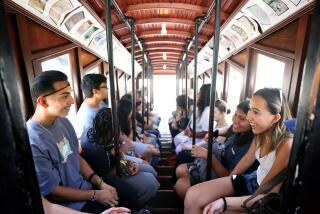A Novel Idea : New Curriculum Lets Junior High Students Relive History
- Share via
GLENDALE — What was it like to travel 3,000 miles on horse and canoe from the Mississippi River to the Pacific Ocean, charting unexplored territory as part of the Lewis and Clark expedition of 1804-06?
Thirty social-studies students at Toll Junior High School were plunged back to the time of Meriwether Lewis and William Clark by reading a new historical novel called “Bold Journey.”
The book, which recounts the trip through the eyes of 20-year-old hired hand Hugh McNeal, is supplemental reading for the new literature-based, multicultural social studies curriculum adopted last year by the Glendale Unified School District.
With teacher Bill Sanderl reading out loud, the class relived the experiences of McNeal as he and about 30 other men rode up the Missouri River, hunkered down for the winter in the Badlands of North Dakota, clambered over the Rocky Mountains and then down to the Pacific Ocean. Along the way, they tried not to dwell on stories from other explorers about hostile Indians.
Charles Bohner’s book is filled with detail and color. Students learned the Shoshone word for white man: “Ta-ba-bone.” They heard McNeal’s description of spoken Shoshone: “It sounded like pebbles rattling in a cedar bucket.” They learned that Clark had a shock of red hair and Lewis a foul temper, and that the coastal Indians ate dried salmon and berries and made jewelry out of seashells.
Eventually, they also learned that the American Indians were not the savages that other frontiersmen had described. McNeal gets to know a young Shoshone woman named Sacajawea who, with her husband, a French fur trapper named Charbonneau, helped guide the expedition into the mysterious North American interior. In the process, he underwent a revelation about American Indians and realized that the explorers and the tribes shared a common humanity.
“To tell the truth, I had always thought of these Indians as not much different from the animals out there on the prairie,” McNeal reflects toward the end of the book.
The Shoshone “lived for most of the year with nothing to eat but a few berries. But they gladly shared what little they had with us. . . . The Shoshone were always open with us. Most of all they wanted to be free, and they wanted you to be free.
“As poor and lonely and harried as they were, they had discovered a secret. Whatever it is, it will die with their last warrior. I wonder whether the victory of the white man, who will surely hound them and conquer them, will make him as happy as his gallant victims.”
McNeal’s words rang in the ears of the eighth-grade class one recent morning, as Sanderl talked about prejudice born of ignorance. His students grasped the idea readily.
Paul Abraham, 14, conceded that he too might have been afraid of Indians at first if he had been on the expedition. “I wouldn’t know how they would react when we met them,” he explained.
But after reading “Bold Journey,” Paul reckoned his sympathies stood with the native people. “Indians weren’t bad people, they were just protecting their land, and I’d fight for my land too.”
Besides, Paul added, “The Indians did a lot of good things. They gave the explorers food and clothes and helped them survive during the winter.”
Sanderl, who has a master’s degree in U.S. history, gave students handouts from a history book and explained the origins of the Lewis and Clark expedition, which was ordered by President Thomas Jefferson after he made the Louisiana Purchase from France’s Napoleon.
Then Sanderl moved into the novel, which students read over six days. Sanderl initially had students read aloud, but said he was forced to abandon that when class attention wandered during passages by slower readers.
So he took over, occasionally gauging the concentration of students by calling on a fidgeter to read a few words. Sanderl said he devoted so much class time to the book because “I want them to get the idea that history is a story well told. So I just walk around and read it with a bit of passion and energy and emotion.
“I try to make it really come alive. If I can keep it moving, they stay focused.”
Sanderl also had students exercise their imaginations by writing three diary entries describing what they might have experienced on the journey.
“My body is aching and I am cold and wet,” wrote Sarah Won. “Tomorrow it will be snowing and we’ll probably be lucky if we see any sun. This is only the beginning of our long journey. But this hardship only helps for what is going to happen further along our journey. It will help make us strong.”
Some students, including Paul Abraham, said they identified with Hugh McNeal and would have signed up eagerly for the chance to pit their wits against the hostile land.
Others, like Steve Jackson, 12, said the hired hands got none of the glory of Lewis and Clark but had to put up with a lot of hardship.
But many echoed Monica Herrada, 13, who said the novel was full of adventure and made her want to know more about Lewis and Clark’s expedition.
“I love reading and it’s fun to see different points of view,” Monica said. “It’s much better than reading from the history book.”
More to Read
Sign up for our Book Club newsletter
Get the latest news, events and more from the Los Angeles Times Book Club, and help us get L.A. reading and talking.
You may occasionally receive promotional content from the Los Angeles Times.








